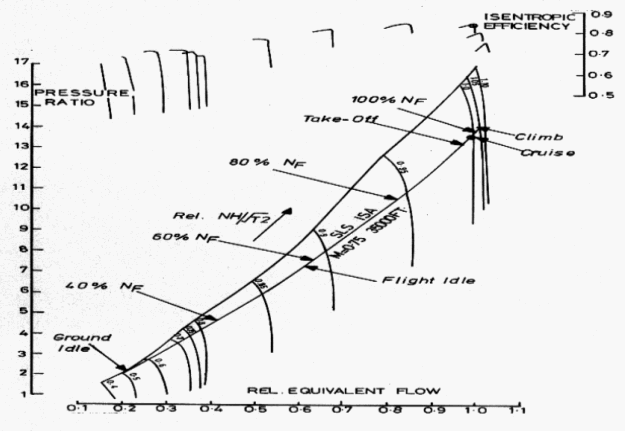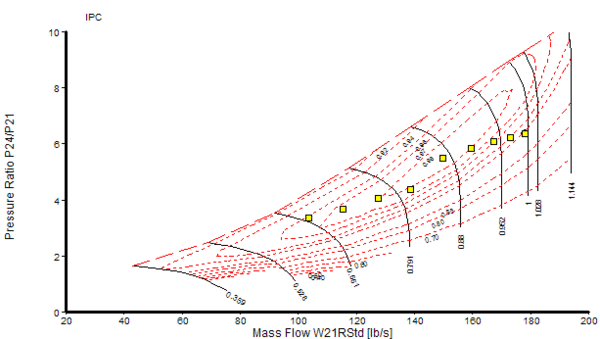Compressor map
A compressor map is a chart created for a compressor in a gas turbine engine. Complete maps are based on compressor rig test results or predicted by a special computer program. Alternatively the map of a similar compressor can be suitably scaled.
Compressor maps are an integral part of predicting the performance of a gas turbine engine, both at design and off-design conditions. Fans and turbines also have operating maps, although the latter are significantly different in appearance to that of compressors.
High pressure compressor map

Flow axis
The x-axis is usually some function of compressor entry mass flow, usually corrected flow or non-dimensional flow, as opposed to real flow. This axis can be considered a rough measure of the axial Mach number of the flow through the device.
Pressure ratio axis
Normally the y-axis is pressure ratio (Pexit/Pinlet), where P is stagnation (or total head) pressure.
ΔT/T (or similar), where T is stagnation (or total head) temperature, is also used.
Surge line
The slightly kinked diagonal line on the main (i.e. lower) part of the map is known as the surge (or stall) line. Above this line is a region of unstable flow, which is an area best avoided.
A compressor surge typically causes an abrupt reversal of the airflow through the unit, as the pumping action of the airfoils stall (akin to an aircraft wing stalling).
Surge margin
As the name suggests, surge margin provides a measure of how close an operating point is to surge. Unfortunately, there are a number of different definitions of surge margin. A popular one in use is defined as follows:
where:
is the mass flow at the operating point, be it steady state or transient
is the mass flow at surge, at same corrected speed as
Speed lines
The slightly curved, near vertical, lines on the main part of the map are the (constant rotational) corrected speed lines. They are a measure of rotor blade tip Mach number.
Note on the illustration that the speed lines are not distributed linearly with flow. This is because this particular compressor is fitted with variable stators, which open progressively as speed increases, causing an exaggerated increase in flow in the medium to high speed region. At low speed, the variable stators are locked, causing a more linear relationship between speed and flow.
Also note that beyond 100% flow, the speed lines close up rapidly, due to choking. Beyond choke, any further increase in speed will generate no further increase in airflow.
Efficiency axis
A sub-plot shows the variation of isentropic (i.e. adiabatic) efficiency with flow, at constant speed. Some maps use polytropic efficiency. Alternatively, for illustrative purposes, efficiency contours are sometimes cross-plotted onto the main map.
Note that the locus of peak efficiency exhibits a slight kink in its upward trend. This is due to the choking-up of the compressor as speed increases, with the variable stators closed-off. The trend line resumes, once the variables start to move open.
Working line
Also shown on the map is a typical steady state working (or operating/running) line. This is a locus of the operating points of the engine, as it is throttled.
Being a high pressure ratio device, the working line is relatively shallow. If the unit had no variable geometry, there would be handling problems, because the surge line would be very steep and cross the working line at part-flow.
During a slam-acceleration from a mid-throttle setting, the compressor working line will move rapidly towards surge and then slowly approach the steady state operating point, further up the map. The reverse effect occurs during a slam-deceleration. These effects are caused by the sluggish response of the spool (i.e. inertia effects) to rapid changes in engine fuel flow. Compressor surge is a particular problem during slam-accelerations and can be overcome by suitable adjustments to the fueling schedule and/or use of blow-off (bleeding air off the compressor, for handling purposes).
In the particular example shown, a slam-acceleration from ground idle would cause a high pressure compressor surge. Opening the blow-off would help, but some changes to the variable stator schedule might also be required.
Because a high pressure compressor 'sees' the choked flow capacity of the high pressure turbine, the compressor working line is hardly affected by flight conditions. The slope of the working line approximates to a constant corrected outlet flow.
Fan map
As the second illustration shows, a low pressure ratio fan (such as that used on a high bypass ratio turbofan) has a range of working lines. At high flight speeds, the ram pressure ratio factors up the cold nozzle pressure ratio, causing the nozzle to choke. Above the choking condition, the working lines tend to coalesce into a unique steep straight line. When the nozzle unchokes, the working line starts to become more curved, reflecting the curvature of the nozzle characteristic. With falling flight Mach number, the cold nozzle pressure ratio decreases. Initially this has no effect upon the position of the working line, apart from the curved (unchoked) tail, which becomes longer. Eventually, the cold nozzle will become unchoked at lower flight Mach numbers, even at full throttle. The working lines will now become curved, gradually migrating towards surge as flight Mach number decreases. The lowest surge margin working line occurs at static conditions.
Owing to the nature of the constraints involved, the fan working lines of a mixed turbofan are somewhat steeper than those of the equivalent unmixed engine.
The fan map shown is for the bypass (i.e. outer) section of the unit. The corresponding inner section map typically has longer, flatter, speed lines.
Military turbofans tend to have a much higher design fan pressure ratio than civil engines. Consequently, the final (mixed) nozzle is choked at all flight speeds, over most of the throttle range. However, at low throttle settings the nozzle will unchoke, causing the lower end of the working lines to have a short curved tail, particularly at low flight speeds.
However, ultra-high bypass ratio turbofans have a very low design fan pressure ratio (e.g. 1.2, on the bypass section). Consequently, even at cruise flight speeds, the cold (or mixed final) propelling nozzle is unchoked. The fan working lines become more spread-out with flight Mach number, because they move bodily up the map, towards the top right hand corner. As a result, the static working line can be well into surge.
One solution is to have a variable area cold (or mixed) nozzle. Increasing the nozzle area at low flight speeds brings the fan working line away from surge.
An alternative solution is to fit a variable pitch fan. Scheduling the pitch of the fan blades has no impact upon the position of the fan working lines, but can be used to move the surge line upwards, to improve fan surge margin.
IP compressor map
Some turbofans have an intermediate pressure (IP) compressor located between the fan and the high pressure (HP) compressor to increase overall pressure ratio. US civil engines tend to mount the IP compressor on the LP shaft, directly behind the fan, whereas Rolls-Royce normally mount the IP compressor on a separate (i.e. IP) shaft, which is driven by an IP turbine. Either way, matching problems can arise.
The IP compressor outlet corrected flow must match the entry corrected flow of the HP compressor, which is decreasing as the engine is throttled back. At a certain IP compressor working line slope, the IP compressor outlet corrected flow remains constant. However, by adopting a shallower working line, the extra IP compressor pressure ratio at a given IP compressor entry corrected flow enables the IP compressor outlet corrected flow to decrease and match up with the falling HP compressor entry corrected flow. Unfortunately this can lead to a poor IP compressor surge margin at part flow.

Surge margin can be improved by adding variable stators to the IP compressor and/or adding a blow-off valve between the IP and HP compressors. The former makes the IP compressor surge line shallower, swinging it away from the shallow working line, thus improving IP compressor surge margin.
At a given IP compressor pressure ratio, opening the blow-off valve forces the IP compressor entry corrected flow to increase, to a point where the IP compressor surge margin tends to be better. Effectively, opening the blow-off valve lowers the IP compressor working line. Any flow surplus to that demanded by the HP compressor passes through the blow-off valve into the bypass duct. The blow-off valve is normally only opened at throttled conditions, since it wastes energy.


External links
- Speed-Wiz Turbocharger Compressor Map Calculation
- SoftInWay Inc. Performance and Efficiency Maps of Centrifugal Compressor